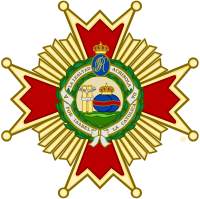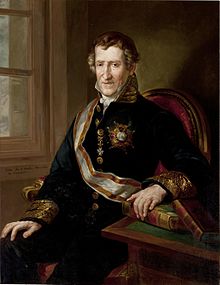
Back وسام إيزابيلا الكاثوليكية Arabic Orde de Sabela la Católica AST Ордэн Ізабелы Каталічкі Byelorussian Orde d'Isabel la Catòlica Catalan Řád Isabely Katolické Czech Orden de Isabel la Católica German Orden de Isabel la Católica Spanish Elisabet Katolikoaren Ordena Basque Isabella Katolilaisen ritarikunta Finnish Ordre d'Isabelle la Catholique French
| Order of Isabella the Catholic | |
|---|---|
 Breast star of the Order | |
| Awarded by the Spanish Monarch | |
| Type | Order of merit, Knighthood |
| Established | 1815 |
| Motto | A LA LEALTAD ACRISOLADA (To Proven Loyalty) and POR ISABEL LA CATÓLICA (For Isabella the Catholic) |
| Awarded for | Actions in benefit to Spain and the Crown |
| Status | Currently constituted |
| Grand Master | King Felipe VI |
| Grand Chancellor | José Manuel Albares, Minister of Foreign Affairs |
| Grades |
|
| Precedence | |
| Next (higher) | Order of Charles III (sorted by year of inception) |
| Next (lower) | Order of Civil Merit (sorted by year of inception) |
The Ribbons of the Order | |


The Royal Order of Isabella the Catholic (Spanish: Real Orden de Isabel la Católica) is a knighthood and one of the three preeminent orders of merit bestowed by the Kingdom of Spain, alongside the Order of Charles III (established in 1771) and the Order of Civil Merit (established in 1926). It recognizes extraordinary services to the homeland or the promotion of international relations and cooperation with other nations, with a particular focus on the territories of the former Spanish Empire. By law, its Grand Master is the King of Spain, and its Grand Chancellor is the Minister of Foreign Affairs. The Order is open to both Spaniards and foreigners, particularly from the Spanish-speaking world.
The Order was created in 1815 by King Ferdinand VII in honor of Queen Isabella I as the Real y Americana Orden de Isabel la Católica ("Royal and American Order of Isabella the Catholic") with the intent of "rewarding the firm allegiance to Spain and the merits of Spanish citizens and foreigners in good standing with the Nation and especially in those exceptional services provided in pursuit of territories in America and overseas."[1] The Order was reorganized by royal decree on 26 July 1847, with the name "Royal Order of Isabella the Catholic", reflecting the secession of the mainland possessions in the Americas after the Spanish American wars of independence.
The great prestige that the Order of Isabella the Catholic enjoys in Spain and abroad is due to several reasons. First, it has become a powerful instrument of international relations, with awardees inducted from all over the world.[2] Second, it is a highly selective and rare honour – since its creation in 1815, only 72,398 people have received the Order of Isabella the Catholic[3] (in comparison, the also prestigious French Legion of Honour has been awarded to over 1,000,000 people over the same period of time,[4] and the Order of the British Empire has over 100,000 living members[5]). Third, it is the only Spanish civil honour that confers personal nobility, with the right to an individual coat of arms (with heraldic mantle and pavilion), an official style of address (The Most Illustrious Sir / Ilustrísimo Señor), and full membership in nobiliary corporations (e.g., the Real Asociación de Hidalgos).[6]
- ^ "premiar la lealtad acrisolada a España y los méritos de ciudadanos españoles y extranjeros en bien de la Nación y muy especialmente en aquellos servicios excepcionales prestados en favor de la prosperidad de los territorios americanos y ultramarinos"
- ^ de Ceballos-Escalera y Gila, Alfonso (2015). La Real y Americana Orden de Isabel La Catolica (in Spanish) (1st ed.). Madrid, Spain: Boletin Oficial del Estado. pp. 23–24.
- ^ de Ceballos-Escalera y Gila, Alfonso (2015). La Real y Americana Orden de Isabel La Catolica. Boletin Oficial del Estado. p. 186.
- ^ Wattel, Michel et Beatrice (2009). Les Grand'Croix de la Légion d'honneur. De 1805 à nos jours, titulaires français et étrangers. Archives et Culture.
- ^ "The Official Website of the British Monarchy".
- ^ Barrios Pintado, Feliciano; Alvarado Planas, Javier; Gómez Sánchez, Yolanda (2012). La Nobleza No Titulada en España: Dictamen Jurídico (PDF) (in Spanish) (1st ed.). Madrid, Spain: Ediciones Hidalguia. pp. 41–42.
© MMXXIII Rich X Search. We shall prevail. All rights reserved. Rich X Search